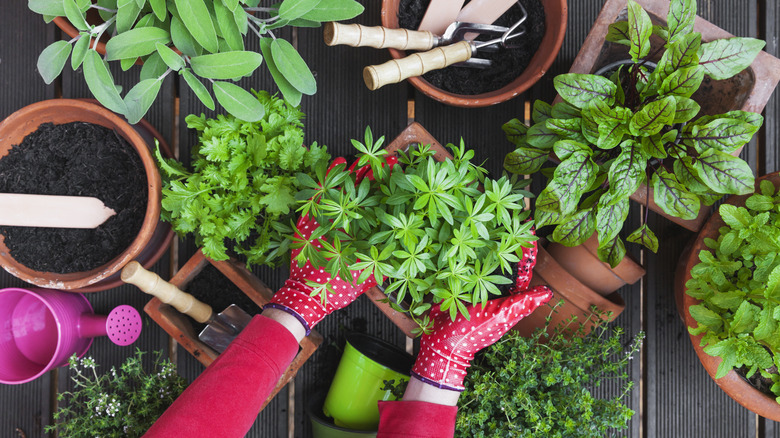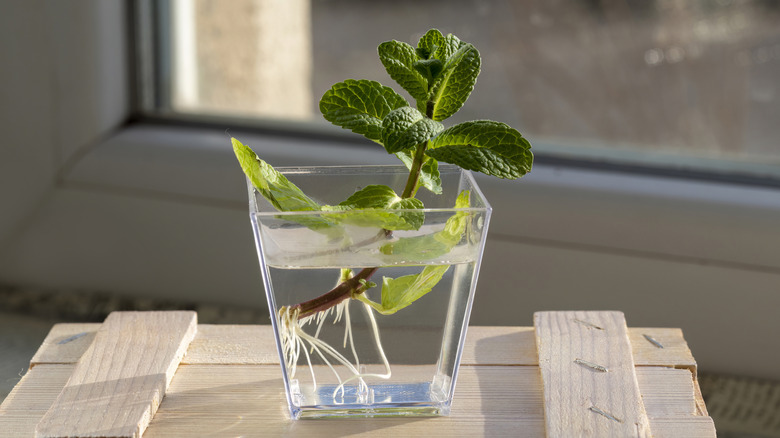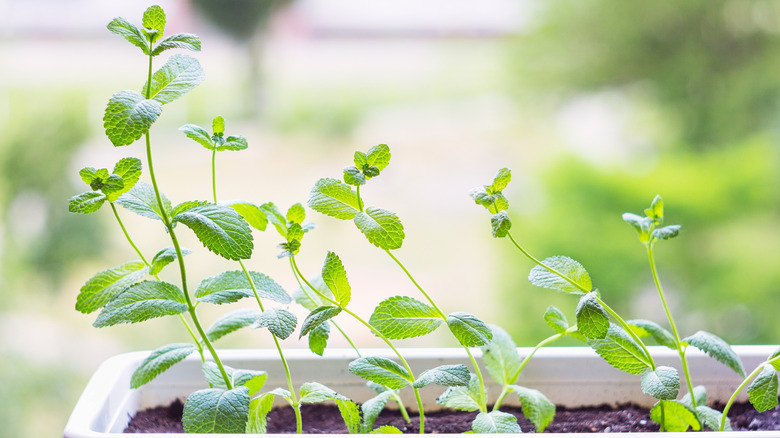The Popular Herb You Should Grow From Cuttings Instead Of Seeds
Growing mint from seeds can be an exercise in patience for any gardener, regardless of their experience level. The seeds themselves are slow to sprout, tiny, and often produce weak or inconsistent plants. Even seasoned gardeners struggle to grow mint. That's why most tend to skip the seed step entirely, instead going straight for cuttings. It's faster, simpler, and way more dependable — especially if you plan to use the mint in your cooking. A cutting is already part of a mature plant, and it just needs roots to become independent. Thankfully, mint makes this process easy. With a bit of moisture and warmth, it happily sends out roots in just days. You can clip it from a friend's garden or your own kitchen plant to expand your mint collection. With the right conditions, you'll have new mint in no time!
One surprising benefit of growing mint from a clipping is consistency, specifically in terms of flavor and aroma. Planting seeds can be a gamble, as mint is known to cross pollinate with other plants, and it may not produce the desired flavor you're aiming for. You may end up fostering plants with different growth habits, environmental needs, or tastes. But a cutting is a genetic match to the parent plant, so what you see is exactly what you will get. If you love the smell of a special spearmint plant or the punch of your home-grown peppermint, a cutting ensures that those traits stay intact. Instead of planting a few seeds and just hoping that they take, you can start with one simple, strong stem. In fact, since mint tends to spread quickly, one or two rooted cuttings is all you really need for a consistent supply of fresh herbs.
Should you grow mint cuttings in water or soil?
One of the most important steps in propagating a mint cutting is determining whether or not you want it to grow in soil or water. Each has its own set of unique advantages when it comes to plant growth, and your choice ultimately comes down to your comfort level with plants. Growing cuttings in water is a beginner-friendly method that allows you to see the roots as they develop. You can watch the roots form day by day, which can make the process feel more rewarding. The increased visibility can also help beginner gardeners make adjustments, gauge water levels, monitor the amount of necessary sunlight, and keep an eye out for early signs of root rot. It's also ideal for indoor growers who want to keep a steady supply of fresh herbs propagated from cuttings. Propagating with water is proven to be effective at producing healthy root systems that should allow your mint to grow.
On the other hand, soil propagation has its own perks — especially if you're thinking more long-term. A cutting that's rooted in soil gets to skip the stressful transition from water to dirt, meaning a mature plant will begin to grow faster. Additionally, you may be able to reduce transplant shock by starting your plant directly in soil. A mint cutting propagated in soil may also be better adapted to real world conditions, like changing humidity levels or heavier growing mediums, as the roots will be sturdier. Soil rooting is ideal if you plan to grow your mint outdoors or if you want a cutting that's ready to take off the moment it establishes. With that being said, this method is not as beginner-friendly as water propagation, as you cannot see what is happening below the surface.
How to grow a mint cutting
Ready to try propagating a mint cutting yourself? Let's start with the water method. Cut a 4-inch to 6-inch stem from a mint plant, making sure to snip below a node. Use a pair of clean scissors or garden sheers to avoid damaging the plant or the cutting. You don't want to use a stem that is currently flowering. Strip off any lower leaves that may be submerged when the plant is introduced to water, and place the cutting in a clear glass filled with room-temperature water. Set the glass in a sunny but not particularly hot area of your home, like a kitchen windowsill. Replace the water every couple of days to prevent bacteria or mold buildup. After about two weeks, you'll notice roots sprouting. Once the roots grow to about 2 inches long, transfer the cutting into fresh potting mix and water it thoroughly. If you're planting it outdoors, be careful not to place it too close to other plants, as it grows extremely quickly.
If you'd rather skip the water and go straight to soil, the process is still incredibly simple. Prepare a small pot with damp, well-draining soil. Using a cutting of the same size as for water propagation, remove the lower leaves, and plant it into your pot. Ensure that at least one or two nodes are completely buried in the soil, and press it gently to keep the plant upright. You can dip the end of your mint cutting into a hormone that can speed up the development of roots, but this step is optional. You'll wait about two weeks before you should start to notice the emergence of roots from your mint cutting.


